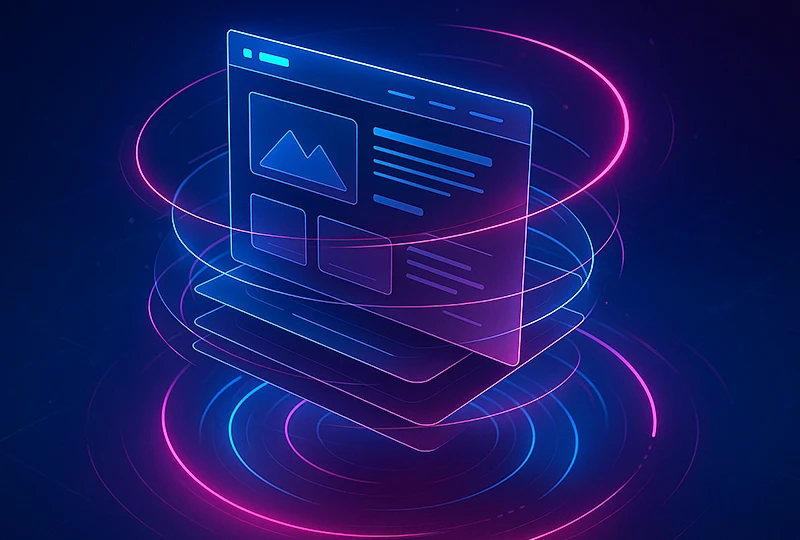
B2B Websites in 2025: How Can Australian Businesses Win More Clients Online?

Australian businesses can win more clients online in 2025 by transforming their websites into high-performing sales tools that attract, educate, and convert prospects. The era of static, brochure-style sites is over. Modern B2B websites are now built to engage the right audience through search, establish trust through proof, and guide decision-makers towards taking action. Businesses that treat their websites as living, sales-driven systems are already outperforming competitors that see them as simple marketing add-ons.

The key to winning online lies in combining strategy, trust, and usability. A successful B2B website brings together clarity, credibility, and user experience to communicate expertise instantly. It should not only look good but also anticipate client needs, tell your story with authority, and make it effortless for visitors to enquire or buy. In today’s digital-first marketplace, your website is your brand, your credibility, and your most powerful salesperson.
What Are the Key Factors That Make a B2B Website Successful in 2025?
To rank well and convert effectively, Australian B2B websites must meet the expectations of modern buyers who research extensively before making contact. A high-performing site stands out by being clear, fast, and credible. These are the foundations that separate client-winning websites from those that quietly lose business.
1. Buyers Expect a Sales-Ready Website
Modern B2B buyers complete most of their research before they ever speak to sales. Your website should therefore act as your top salesperson, educating visitors, addressing their pain points, and guiding them towards the next step. A sales-ready website presents your offer with clarity, confidence, and relevance. It helps potential clients quickly understand who you help, what you do, and how your solution fits their needs.
What makes a website truly sales-ready:
- Communicate a clear and concise value proposition above the fold
- Include strong calls-to-action such as “Book a Demo” or “Request a Quote”
- Provide helpful content such as videos, guides, or articles that support the buying journey
2. Trust Signals Drive Conversions
Trust is the foundation of every successful B2B relationship. Before engaging, buyers look for proof that your business can deliver. Genuine testimonials, detailed case studies, and visible credentials all help to build credibility. When visitors feel confident that your brand is reliable and transparent, they are far more likely to enquire or convert.
How to build trust and credibility on your website:
- Highlight authentic client testimonials and success stories
- Display certifications, awards, and well-known partnerships
- Include a detailed “About” section that introduces your team and expertise
3. Speed and Mobile-First Design Are Essential
Website speed and responsiveness play a major role in how users perceive your business. A fast and mobile-friendly site signals professionalism and care, while a slow or cluttered one can push visitors away. With most B2B research now happening on mobile devices, optimising for performance across all screens is essential.
How to improve website speed and mobile performance:
- Optimise images, videos, and code for faster loading
- Use responsive layouts that adapt seamlessly to different devices
- Simplify design elements for easy navigation and a better user experience
4. Personalisation Boosts Engagement
Personalisation has become a key driver of engagement and conversions. Visitors respond better to tailored experiences that speak directly to their industry, goals, or challenges. By using AI tools and CRM integrations, businesses can deliver relevant content and messaging that feel personal and timely.
How to personalise your B2B website experience:
- Implement AI-driven content that adjusts to visitor behaviour or preferences
- Add smart chatbots that provide instant, context-aware assistance
- Use CRM data to create segmented, targeted follow-ups
5. SEO and Content Depth Fuel Visibility
Visibility determines success in 2025. Even the most visually impressive website cannot perform without strong SEO and valuable content. Publishing expert-level insights helps attract the right audience, establish authority, and keep your brand top of mind during the research phase.
How to strengthen SEO and grow your website’s visibility:
- Optimise each page for relevant keywords and search intent
- Publish consistent long-form content that educates and informs
- Build internal links that improve navigation and boost SEO performance
People also ask:
What are the key elements of a successful B2B website in 2025?
Clear messaging, trust signals, and fast, mobile-friendly design make a B2B website successful.
How can Australian B2B websites improve visibility and conversions?
They can boost performance through local SEO, strong content, and clear calls-to-action.
Why is SEO critical for B2B website success?
SEO increases visibility, attracts qualified leads, and builds brand authority online.
Why Is a B2B Website So Crucial for Australian Businesses?
The B2B buying process has changed dramatically. More than 70 per cent of a buyer’s journey now happens online before any contact with a salesperson. That means your website must build trust and authority on its own.
In Australia, where small and mid-sized enterprises compete globally, a well-designed website often determines whether you are shortlisted or overlooked. A Brisbane logistics firm or a Melbourne consultancy can compete with international players if their website communicates expertise, clarity, and relevance effectively.
People also ask:
Why is my B2B website not generating leads?
Because it is built to inform rather than convert. A strong website guides users towards clear next steps.
Can a small Australian business compete online with global firms?
Yes, with a website that builds authority through proof, trust, and local expertise.
What Features Should Every B2B Website Include to Attract Clients?
If you are asking, “What does a high-performing B2B website need to attract and convert clients?”, the answer lies in structure, clarity, and trust.
The most effective websites feature a clear value proposition, responsive design, and fast load times. Prominent calls-to-action such as “Book a Demo” or “Request a Quote” encourage engagement, while supporting proof such as case studies or certifications reinforces credibility.
Content plays a central role. Detailed blogs, thought leadership articles, and whitepapers help establish authority and drive SEO performance. Meanwhile, live chat and AI-powered chatbots reduce friction by answering queries instantly.
How Are Australian Businesses Adapting Their B2B Websites?
Australian B2B websites are shifting towards simplicity, substance, and trust. Clarity has replaced clutter as the mark of professionalism, and purpose-led design is driving engagement.
Key trends include:
- Minimalist layouts: Clean, functional design enhances focus and confidence.
- Local-first SEO: Optimising for searches like “consultants in Sydney” improves visibility.
- Personalisation with AI: Industry-specific messages resonate better with each visitor.
- Sustainability statements: Ethical positioning strengthens brand reputation.
- CRM integration: Connecting your site to HubSpot or Salesforce ensures no lead is lost.
This evolution reflects a maturing digital landscape where effectiveness outweighs flashiness.

Which Platform Should You Use to Build a B2B Website?
Many Australian business owners ask, “Should I build my B2B website on Webflow, WordPress, or Shopify?” The answer depends on your goals.
Webflow suits design-led companies that value creative control with minimal code.
WordPress remains the best choice for content-heavy businesses that rely on SEO.
Shopify is ideal for product-driven B2B operations such as wholesalers.
Custom builds using frameworks like Bootstrap work best for enterprises that need total flexibility.
Most Australian SMEs find the best combination of scalability and cost-efficiency with either WordPress or Webflow.
People also ask:
Is Webflow better than WordPress for B2B websites?
Webflow gives greater design flexibility, while WordPress provides better SEO tools and plugins.
Can Shopify handle B2B sites?
Yes, Shopify Plus now includes wholesale pricing, bulk orders, and advanced B2B functions.
How Can a B2B Website Generate More Leads and Sales?
A B2B website succeeds when it functions like a lead generation system rather than a static brochure. The secret lies in combining strong content with clear conversion pathways.
Top-performing websites use educational resources like guides, whitepapers, or videos to nurture leads. They include CTAs on every page to push visitors towards action, and interactive tools such as ROI calculators to increase engagement.
The key principle is simple: provide value first. The more useful and insightful your content, the more qualified your leads become.
What Mistakes Still Stop B2B Websites from Performing Well?
Even in 2025, many Australian B2B websites still fail to perform because they neglect core principles that drive engagement and conversion. These weaknesses often come down to unclear messaging, slow performance, and a lack of trust-building elements. Without data and optimisation, these issues persist unnoticed, causing lost opportunities and lower credibility.
Common mistakes that hold websites back:
- Unclear positioning: Visitors should understand your value within seconds.
- Poor speed and usability: Slow pages kill trust.
- Lack of proof: No case studies or testimonials equals low credibility.
- Overly technical copy: Simplicity and results-driven language work best.
- No analytics tracking: Without insights, optimisation never happens.
Avoiding these pitfalls transforms an underperforming website into a high-performing sales platform.
People also ask:
Why is my B2B website underperforming?
It often lacks clarity, speed, or a clear conversion flow.
Is it better to focus on design or results?
Always focus on results. A simple site that converts beats a complex one that confuses users.
How Can Businesses Keep Their B2B Websites Competitive?

Staying competitive requires continual optimisation, not one-time redesigns. The best-performing websites are treated as evolving systems that grow through data and iteration.
Audit your analytics monthly, refresh content quarterly, and test your conversion flow regularly. Refining navigation, updating blog content, and improving page speed consistently compound results.
AI-driven personalisation tools now allow you to predict buyer behaviour and adjust user journeys in real time, helping you convert prospects before competitors even respond.
A website that adapts and improves continuously will always outperform one that stands still.
Final Thoughts
In 2025, your website is your first impression, your pitch, and your proof of expertise all at once. Australian buyers expect speed, trust, and precision before they ever contact sales.
Companies that view their websites as living sales systems built on credibility, clarity, and optimisation will lead their industries. Those that fail to evolve risk being invisible.
Now is the time to assess your site. Does it clearly express your value? Does it make it easy for potential clients to take action? If not, this year is your chance to turn it into your most powerful sales asset.
If you’re ready to enhance your B2B website or want to keep learning, explore more insights in our Media Hub. And if you need expert guidance to turn your website into a client-winning platform, we’re here to help.
FAQs
1. How can my B2B website attract more clients?
By focusing on clarity, trust, and usability. Make it easy for visitors to understand what you offer, see your proof of results, and take action quickly.
2. Why is my B2B website not generating leads?
Most sites inform instead of converting. Add clear calls-to-action, social proof like testimonials, and make sure your pages load fast on all devices.
3. Which platform is best for my B2B website?
Webflow is great for design flexibility, WordPress for SEO-focused sites, and Shopify for B2B eCommerce or wholesalers. Choose based on your business goals.
4. How often should I update my website?
Review your website every few months. Update content, refresh case studies, and check analytics to keep performance strong and search rankings high.
5. What’s the biggest mistake B2B websites make?
Lack of clarity. If visitors can’t understand your value within seconds, they’ll leave. Keep your message simple, visual, and results-driven.













%2520-%2520Main%2520Image.jpeg)




